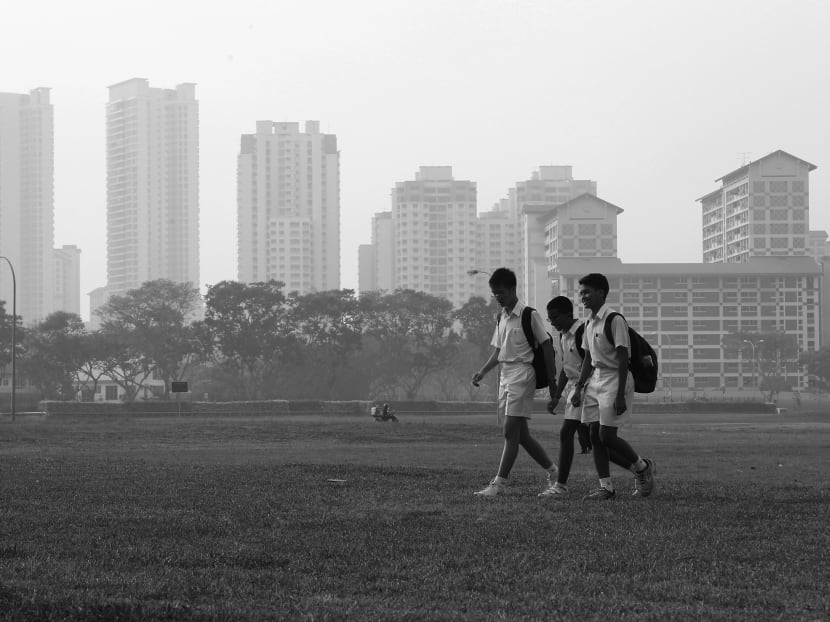Making haze crimes pay
The newly-proposed fine for haze crimes is a crystal-clear sign of the Government’s determination to stop slash-and-burn tactics used by the agroforestry resource sector in land clearing. Announced in Parliament on Monday after a month-long public consultation, the toughened Transboundary Haze Pollution Bill penalises companies up to S$2 million if they subject residents in Singapore to choking haze through their commercial activities. This is an almost seven-fold jump from the earlier proposed fine of S$300,000.

It is unclear if the stiffer fine would be effective in deterring firms that contribute to haze. TODAY FILE PHOTO
The newly-proposed fine for haze crimes is a crystal-clear sign of the Government’s determination to stop slash-and-burn tactics used by the agroforestry resource sector in land clearing. Announced in Parliament on Monday after a month-long public consultation, the toughened Transboundary Haze Pollution Bill penalises companies up to S$2 million if they subject residents in Singapore to choking haze through their commercial activities. This is an almost seven-fold jump from the earlier proposed fine of S$300,000.
However, it is unclear if the stiffer fine would be an effective deterrent. The maximum penalty of S$2 million — to be imposed on companies guilty of causing haze for a continuous period of 20 days or more — may seem punitive, but it is, in fact, a paltry sum to agroforestry firms, which make hundreds of millions, if not billions, in profits every year. If we take the net profit of seven key agroforestry companies last year, a back-of-the-envelope calculation shows that S$2 million represents less than 1 per cent of their average earnings.
Still, even if the fine is not sufficiently high to hurt the bottom lines of bigger players, a conviction should be a strong-enough damper as companies would not want to put their reputations at risk. Any conviction in a Singapore court will affect their financial standing and threaten their access to bank loans and government tax incentive programmes.
What else can Singapore do to strengthen the legislation and prevent a recurrence of the choking haze last year?
SHARPENING THE BILL
First, while the amended Bill makes it possible for individuals to file civil suits against errant firms, most members of the public are unlikely to be able to afford a legal fight. It would be good if an additional provision can be introduced to allow third-party groups, such as a public hospital or non-governmental organisation, to act on their behalf.
Overlapping land concessions in Indonesia are another nagging problem. In Indonesia, which is home to around 70 per cent of the peatlands in South-east Asia, it is not uncommon for the central government, state government agencies or even community leaders to issue permits for the same plot of land to different parties. Worse, such information is not always consolidated and updated at the national level.
While the amended Bill has cast the judicial net wider to make sure all parties involved can be hauled to court, the Government should explore whether to make it explicit that overlapping concessions cannot be accepted as a defence. If such a provision is included in the revised Bill, it would strengthen the deterrence against slash-and-burn or, at least, nudge companies operating on the ground to start working on fire management plans collectively.
Also, Singapore’s collection of fines should not be seen as self-serving. If the court-imposed fines can be partially channelled to the ASEAN Transboundary Haze Pollution Control Fund to help finance haze-fighting efforts in neighbouring countries, it will help boost regional leaders’ receptivity towards the Bill, since their citizens living closest to the hot spots are most likely to benefit from the fund.
REGIONAL COOPERATION IS KEY
Lastly, it is also imperative to secure the cooperation of all Association of South-east Asian Nations governments to operationalise the haze monitoring system (HMS). The system can then host information on hot spot locations and concession maps, so such data can be used as evidence in court.
Leaders from Indonesia, Malaysia and Singapore, in principle, endorsed the HMS last year, when all three countries experienced one of the worst episodes of haze in recent years, but concession maps have yet to be submitted. Without credible evidence on exactly who owns the land where the fires occurred, legal action specified in Singapore’s Transboundary Haze Pollution Bill cannot be taken further.
It is a pity that Indonesia’s outgoing President Susilo Bambang Yudhoyono would probably be unable to see through the implementation of the HMS during the remaining months of his term. With the imminent swearing-in of a new administration, it is important for Singapore to start engaging the next batch of leaders and officials.
Although environmental concerns did not feature prominently in the just-concluded Indonesian presidential election, candidate Joko Widodo — a forestry graduate — had made clear his resolve to tackle overlapping land permits in his team’s manifesto. Mr Prabowo Subianto, who had lived in Singapore when his economist father was forced into exile, also had frequent contact with leaders here during his days in the military.
Not a bad start, it seems, for our leaders and officials to register Singapore’s concerns on Indonesia’s agenda.
ABOUT THE AUTHOR:
Chua Chin Wei is deputy director and fellow for the environment and resources and Cheong Poh Kwan is a policy research analyst at the Singapore Institute of International Affairs.






